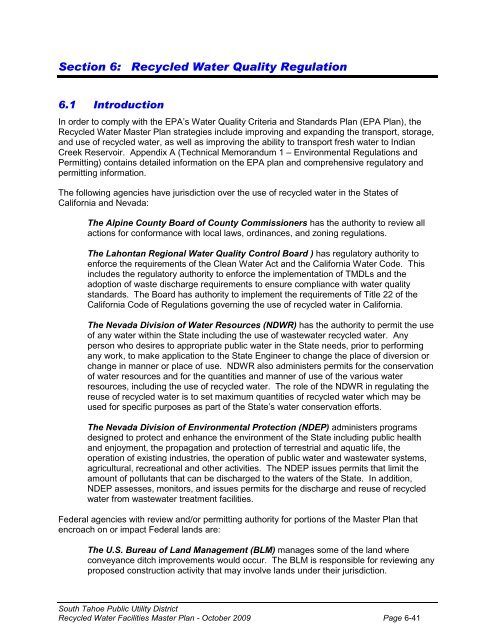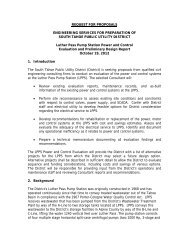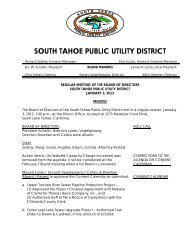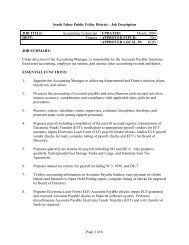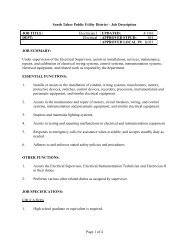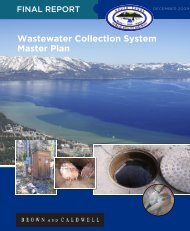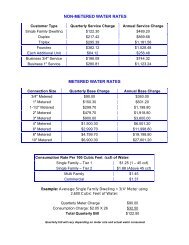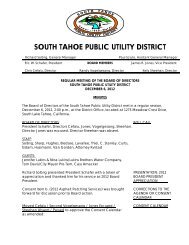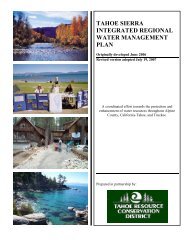October 2009 - South Tahoe Public Utility District
October 2009 - South Tahoe Public Utility District
October 2009 - South Tahoe Public Utility District
Create successful ePaper yourself
Turn your PDF publications into a flip-book with our unique Google optimized e-Paper software.
Section 6: Recycled Water Quality Regulation<br />
6.1 Introduction<br />
In order to comply with the EPA‟s Water Quality Criteria and Standards Plan (EPA Plan), the<br />
Recycled Water Master Plan strategies include improving and expanding the transport, storage,<br />
and use of recycled water, as well as improving the ability to transport fresh water to Indian<br />
Creek Reservoir. Appendix A (Technical Memorandum 1 – Environmental Regulations and<br />
Permitting) contains detailed information on the EPA plan and comprehensive regulatory and<br />
permitting information.<br />
The following agencies have jurisdiction over the use of recycled water in the States of<br />
California and Nevada:<br />
The Alpine County Board of County Commissioners has the authority to review all<br />
actions for conformance with local laws, ordinances, and zoning regulations.<br />
The Lahontan Regional Water Quality Control Board ) has regulatory authority to<br />
enforce the requirements of the Clean Water Act and the California Water Code. This<br />
includes the regulatory authority to enforce the implementation of TMDLs and the<br />
adoption of waste discharge requirements to ensure compliance with water quality<br />
standards. The Board has authority to implement the requirements of Title 22 of the<br />
California Code of Regulations governing the use of recycled water in California.<br />
The Nevada Division of Water Resources (NDWR) has the authority to permit the use<br />
of any water within the State including the use of wastewater recycled water. Any<br />
person who desires to appropriate public water in the State needs, prior to performing<br />
any work, to make application to the State Engineer to change the place of diversion or<br />
change in manner or place of use. NDWR also administers permits for the conservation<br />
of water resources and for the quantities and manner of use of the various water<br />
resources, including the use of recycled water. The role of the NDWR in regulating the<br />
reuse of recycled water is to set maximum quantities of recycled water which may be<br />
used for specific purposes as part of the State‟s water conservation efforts.<br />
The Nevada Division of Environmental Protection (NDEP) administers programs<br />
designed to protect and enhance the environment of the State including public health<br />
and enjoyment, the propagation and protection of terrestrial and aquatic life, the<br />
operation of existing industries, the operation of public water and wastewater systems,<br />
agricultural, recreational and other activities. The NDEP issues permits that limit the<br />
amount of pollutants that can be discharged to the waters of the State. In addition,<br />
NDEP assesses, monitors, and issues permits for the discharge and reuse of recycled<br />
water from wastewater treatment facilities.<br />
Federal agencies with review and/or permitting authority for portions of the Master Plan that<br />
encroach on or impact Federal lands are:<br />
The U.S. Bureau of Land Management (BLM) manages some of the land where<br />
conveyance ditch improvements would occur. The BLM is responsible for reviewing any<br />
proposed construction activity that may involve lands under their jurisdiction.<br />
<strong>South</strong> <strong>Tahoe</strong> <strong>Public</strong> <strong>Utility</strong> <strong>District</strong><br />
Recycled Water Facilities Master Plan - <strong>October</strong> <strong>2009</strong> Page 6-41


